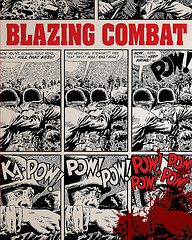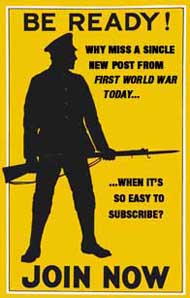The First World War Today
Comics and Graphic Novels
Legendary 1960’s war comic, itself a casualty of war, tells its truth once again
Of 29 battle stories in Fantagraphics’ re-issue of legendary ’60’s war comic Blazing Combat, four are set in WW1. One is about British ace Billy Bishop. Another depicts the American Expeditionary Force at Cantigny.
War is nothing but tragedy – a cutting short of lives that ought to have gone on much longer.
It’s ironic that the life of one of the finest war comics ever published in the 1960’s, Blazing Combat, was itself cut short. It wasn’t for lack of talent. Blazing Combat was written and illustrated by some of the greatest names in 20th-century comics. It died because it succeeded in driving home the tragedy of war. That was bound to draw the ire of powerful entities — ones whose interest lay in promoting a new and costly war… in Vietnam. By its fourth issue, Blazing Combat would be driven from the American publishing scene.
You can’t keep a great comic magazine down
Thankfully, Blazing Combat‘s four-issue run lives again in a single volume from Fantagraphics Books. All 29 stories are there, written by the late, legendary Archie Goodwin and illustrated by such 20th-century comics legends as Wally Wood, Gray Morrow, Alex Toth, John Severin, Russ Heath and Reed Crandall, to name a few.
The conflicts depicted in Blazing Combat span a 20-some centuries period, from the Peloponnesian war through The American Revolution, the War Between the States, two World Wars, plus Korea and Vietnam. Four stories (“Cantigny,” “Lone Hawk,” “How It Began” and “The Trench.”) are set in the First World War.
The artwork throughout is majestic, unstinting it its attention to detail and accuracy. It’s hard to read these stories and not linger amazed over the breathtaking beauty of artwork by so many comics greats. Every page explodes with masterful design and a realism that thrusts you right into the action.
Goodwin’s tireless research and commitment to telling the most powerful stories possible drives home Blazing Combat‘s central theme: that war is costly, and good men frequently die for no good reason.
How Blazing Combat became a casualty of war
The original publisher of Blazing Combat was James Warren, whose Famous Monsters of Filmland enjoyed enormous success due to the monster and horror movie craze of the eary 1960’s. A sister publication, Creepy, featured black and white horror comics not subject to Comics Code restrictions and drawn by the same great artists mentioned above.
Released in October 1965, Blazing Combat‘s first issue appeared to do well. But over the next couple of issues, notes Warren in an interview with Fantagraphics publisher Michael Catron, “problems started… when word got out what the content was.”
Who word got out to was none other than the American military itself and the American Legion. For them, according to Warren, depicting the casualties of war with such relentless realism was anti-American. Warren insists that was never the creators’ intention. Goodwin and his artists’ only intention was to portray war honestly, through great storytelling, without an agenda.
The U.S. military banned sale of Blazing Combat on all its bases — a considerable portion of Warren’s market. The American legion pressured many wholesalers to block distribution of the magazine. By Summer of 1966, unable to absorb the cost so many undistributed copies, Warren was forced to cease publication. A towering milestone in American comic storytelling had been toppled.
Blazing Combat deserved to live far longer than it did. But the truth it expressed goes on. It’s a truth few were ready to hear in the mid-1960’s. In time many did come around, just as today, they appear to be coming around again. It’s the inescapable truth that the human and financial cost of all war — whether in Vietnam or in Afghanistan… on the distant shores of the Pelopponese or across the poppy-stained expanse of Flanders’ fields— is always too high.
Editor/Writer: Archie Goodwin. Illustrators: Frank Frazetta, Wally Wood, John Severin, Al Williamson, Russ Heath, Reed Crandall, Gene Colan, Al MacWilliams, Joe Orlando, Angelo Torres, Gray Morrow, George Evans
Publisher: Fantagraphics Books
Hardcover (ISBN: 978-1-56097-965-4)
Softcover (ISBN: 978-1-60699-366-8)
Learning WW1 history through model kits, movies, books and comics
How do popular cultural forms give relevancy and meaning to an event as seemingly antique as World War One?

The tribulations of German and Australian miners beneath the trenches of Flanders are harrowingly depicted in the film Beneath Hill 60
I happened recently upon a moving YouTube video commemorating the infamous Battle of the Somme, which began on the 1st of July, 1916. In a war that set the standard for wanton wastage of human life, that date marks what remains the bloodiest single day in British military history, with casualties approaching 60 thousand British soldiers killed, wounded or missing.
My introduction to the horrific facts of the Somme was Sebastian Faulks’ epic 1993 novel Birdsong, which, incidentally, is finally in production as a two part television film for the BBC (more on that in an upcoming post). That novel is well worth taking the time to read, especially if you are, like me, a relative newcomer to the First World War. Not least among the many interesting aspects of the novel is its depiction of the miners on both sides whose unenviable (and dangerous!) task was to bore beneath the killing fields of Flanders and France to plant explosives beneath enemy positions. Again, google this subject to learn more. I’d also recommend the excellent, if harrowing, Australian film, Beneath Hill 60, which I intend to write about soon.
Speaking of writing: why this blog? Well, I certainly don’t iplan to expound upon historical arcana in professorial fashion. I am not (at least not yet) enough of an expert for that, and there are plenty of fine Web sites that do it well. (I’ll recommend many as we go along). But I do admit to an insatiable fascination with this cataclysmic, dreadfully sorrowful, but endlessly fascinating era of human history, and a desire to learn more.
Bi-plane kits, old flicks on TV… and Enemy Ace!
It’s an interest first kindled in the mid 1960’s, when I was in my early teens, building my first plastic model kits of quaint double-winged airplanes, the originals of which were flown by daring men with names like Richthofen and Rickenbacker. I read DC comic books starring a red Fokker-flying German known as “Enemy Ace.” On television, if I were lucky, I’d occasionally thrill to old movies like Dawn Patrol and Sgt. York. At the cinema, the big event of 1966 was The Blue Max.
Of course, because of all this, I soon sought out the books, the histories. But my interest in those days was still adolescent, semi-indoctrinated with strange notions of the “glory of war.” It wasn’t until I actually read, a bit later, Erich Maria Remarque’s All Quiet on the Western Front and, soon after, Johnny Got His Gun, Dalton Trumbo’s dreadfully dark indictment of all wars, that I glimpsed the real secret of all wars: war is never glorious, and such enterprise is wasteful and ruinous. No conflict was more profligately so than the First World War, which claimed upwards of 15 million lives, and left few nations unscathed. Eventually, as I came of age and liable for the Vietnam-era draft, other interests came to the fore, and my fascination with the First World War receeded into the background.
Back with a vengeance
It resurfaced, however, some 45 years later. And again, model airplanes were the key! Whether it was a hankering for the scent of enamel paint, a desire to re-create some pleasureable hours of my youth, or just too much too much time on my hands, I don’t know, but I had a powerful desire to build one of those bi-planes again. With the internet, I found that my options had multiplied exponentially. The sheer amount of data available to one now, just on WW1 aircraft, mind-jarring. Beyond that, the universe of WW1 on the Web is vast. You can learn anything there is to know. You can find books aplenty, fiction and non-fiction. Countless films have been made and are there for the discovering. And there is much, so much, more.
That’s where I hope, via this site, to make a contribution: to stimulate interest in this period, especially among “newcomers” like myself… not so much by rehashing the names, places and facts of the war themselves, but by seeking out and examining the many forms the event has taken – literary, artistic, commercial – in the popular mind and culture, over the 97 years since its advent. If as a result we find ourselves seeking to know more about those names, dates and places, so much the better. Because those things are still worth knowing about.
I invite you to join me in the exploration, which should prove interesting, edifying, sobering, entertaining and I’m sure (dare I say it?) fun.
The First World War soon turns 100
Let me quickly add that we’re rapidly approaching, in 2014, the centenary anniversary of that event. In the coming years, we’ll likely start hearing much about those times. Hopefully the more we hear, the less danger there will be of WW1 becoming an antique, forgotten relic of the past. Its terrors, repercussions and echoes remain with us in so many ways. It’s last veterans may have passed away in 2011, but the war itself was too terrible, too profound in its consequences, even for us today, ever to be forgotten.
All text Copyright ©2011 Rick Koobs


